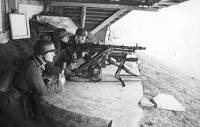The response
Allied airpower had also taken out a number of bridges that prevented counterattack measures at several key locations. As a result, German troops took sometimes long detours in order to reinforce the defenders on the beaches. 
As well, the German counterattacks were not as lethal as they might have been because of a disagreement by two of Germany's top commanders, Rundstedt and Rommel that had to be mediated by Hitler himself. Rundstedt had been the commander originally in charge of constructing the Atlantic Wall; Rommel had finished the job. Rommel was firmly convinced that if the Allied force broke through on the beaches (no matter which beaches they broke through on), then the Allied advantage of airpower would neutralize any German advantage on the ground; therefore, Rommel wanted a large collection of reserves, featuring his vaunted panzer patrols, to be very near the beaches, in order to prevent this kind of breakout. Rundstedt was of the opinion that the reserves should be stationed between the beaches and the interior of France. Hitler agreed with Rundstedt. It was Rundstedt who marshaled the initial defenses on D-Day because Rommel, thinking that the bad weather would preclude any Allied attack, was celebrating his wife's birthday far from the front. By the time he arrived on the scene, it was too late. The next few days
The Normandy landings were the largest amphibious invasion in history. By no means a sure thing, they succeeded despite considerable odds. Once Allied forces were established on the beaches of Normandy, they would not relinquish that control; rather, they were the ones doing the dictating, pushing German troops farther and farther back east. France was liberated in August 1944. What had started as a mission dependent on the whims of the tides had ended up turning the tide of the war in the Allies' favor. The pendulum would not swing back. First page > Axis and Allies > Page 1, 2, 3, 4, 5 |
|
Social Studies for Kids
copyright 2002–2025
David White




